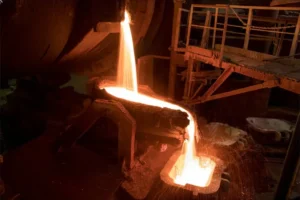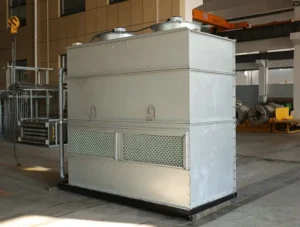“অ্যালার্ম যাইহোক বন্ধ হবে”: ডিবাঙ্কিং 5 ইন্ডাকশন ফার্নেস অপারেশনে মারাত্মক সুরক্ষা ভুল ধারণা

কাস্টিং এবং ধাতব শিল্পে, মাঝারি-ফ্রিকোয়েন্সি আনয়ন চুল্লিগুলি তাদের দক্ষতা এবং নমনীয়তার জন্য ব্যাপকভাবে ব্যবহৃত হয়. যাহোক, তাদের উচ্চ তাপমাত্রার অপারেটিং পরিবেশ, উচ্চ চাপ, এবং শক্তিশালী বৈদ্যুতিন চৌম্বকীয় ক্ষেত্রগুলি উল্লেখযোগ্য সুরক্ষা ঝুঁকির সাথে রয়েছে. যদিও আধুনিক ইন্ডাকশন চুল্লিগুলি একাধিক অ্যালার্ম সিস্টেমে সজ্জিত, একটি আত্মতৃপ্ত মানসিকতা “অ্যালার্ম যাইহোক বন্ধ হবে” কিছু অপারেটরদের মধ্যে চুপচাপ বাড়ছে. এই মানসিকতা মারাত্মক সুরক্ষা ভুল ধারণাগুলির একটি সিরিজকে উত্সাহিত করতে পারে, কর্মীদের সমালোচনামূলক বিপদ সংকেত উপেক্ষা করে এবং শেষ পর্যন্ত বিপর্যয় দুর্ঘটনার দিকে পরিচালিত করে.
এই নিবন্ধটি অপারেটরদের যে পাঁচটি সমালোচনামূলক সুরক্ষা ভুল ধারণা রয়েছে তা প্রকাশ করবে এবং তাদের পিছনে লুকানো বিপদ সংকেতগুলির বিশদ রয়েছে, ফ্রন্টলাইন কর্মীদের জন্য একটি পরিষ্কার সতর্কতা শোনার লক্ষ্য.
ভুল ধারণা 1: অ্যালার্মটি একটি রৌপ্য বুলেট যা আগাম সমস্ত বিপদ সম্পর্কে সতর্ক করবে
বিপদ সংকেত: চুল্লি ফুটো জন্য স্বয়ংক্রিয় অ্যালার্ম সিস্টেমে অতিরিক্ত নির্ভরতা, জল চাপ, এবং তাপমাত্রা, রুটিন সরঞ্জাম পরিদর্শন এবং সূক্ষ্ম অসঙ্গতিগুলির পর্যবেক্ষণ অবহেলা করার সময়.
“একটি চুল্লি ফাঁস অ্যালার্ম আছে; ব্রেকআউট ঘটতে থাকলে এটি শোনাবে।” এটি সবচেয়ে সাধারণ এবং বিপজ্জনক ভুল ধারণা. বাস্তবে, একটি অ্যালার্ম হয় প্রতিরক্ষা শেষ লাইন সুরক্ষার জন্য, ঝুঁকির পূর্বাভাস দেওয়ার জন্য কোনও স্ফটিক বল নয়. Its operating principle is mostly based on detecting sudden changes in induction current or ground resistance.
The Overlooked Fatal Details:
- Alarm Lag: By the time an alarm sounds, damage to the furnace lining has often already occurred, and molten metal may have even started a minor leak. It is only one step away from a major breakout accident. The alarm cannot predict the gradual thinning of the lining or the formation of local cracks.
- Alarm Blind Spots: The installation position of the alarm probe, its sensitivity settings, and the integrity of the grounding system all directly affect its reliability. উদাহরণ স্বরূপ, if a leak occurs outside the probe’s detection range or if poor grounding prevents the signal from being transmitted accurately, the alarm system may fail completely.
- দ্য “Cry Wolf” প্রভাব: Unstable power supplies, humid environments, or incorrect parameter settings can cause false alarms. Frequent false alarms can desensitize operators, leading them to dismiss a real danger signal as just another “system glitch.”
How to Debunk It: Never place your complete trust in an alarm system. Insist on a visual inspection of the furnace lining after tapping each heat, paying attention to color changes, cracks, pitting, or bulging. Trust your experience and intuition; any minor abnormality is worth shutting down for an inspection.
ভুল ধারণা 2: A Small Fluctuation in Cooling Water Pressure/Temperature is No Big Deal
বিপদ সংকেত: Ignoring the slight swing of a pressure gauge needle, a minor drop in a flow meter reading, or a sustained high temperature at the outlet of a cooling water cable.
Critical components of an induction furnace, যেমন ইন্ডাকশন কয়েল এবং পাওয়ার কেবলগুলি, জোর করে শীতল করার জন্য জল সঞ্চালনের উপর নির্ভর করুন. অনেক অপারেটর কেবল অ্যালার্ম প্রান্তিকের নীচে জল চাপের নীচে কিনা সেদিকে মনোযোগ দিন, সামান্য ওঠানামা বরখাস্ত করা.
The Overlooked Fatal Details:
- একটি নাবালকের পিছনে গল্প চাপ ড্রপ: একটি অবিচ্ছিন্ন, শীতল জলের চাপে সামান্য হ্রাস একটি সাধারণ পাম্পের ওঠানামা নাও হতে পারে তবে একটি ক্ষুদ্র নির্দেশ করতে পারে, পাইপলাইনে কোথাও হার্ড-টু-ফাইন্ড ফাঁস. যদি এই ফুটো পয়েন্টটি চুল্লি শরীরের কাছাকাছি বা লাইভ বৈদ্যুতিক অংশগুলির কাছাকাছি চলে যায়, এটি সহজেই একটি শর্ট সার্কিট বা বাষ্প বিস্ফোরণকে ট্রিগার করতে পারে.
- প্রবাহ পরিবর্তনের জড়িত: প্রবাহের হারের একটি ছোট পরিবর্তন পাইপগুলিতে কোনও বাধা বা স্কেল বিল্ডআপের সংকেত দিতে পারে. যদি বাধা আরও খারাপ হয়, এটি কুণ্ডলীটির স্থানীয় ওভারহিটিংয়ের দিকে পরিচালিত করবে, এর নিরোধক ক্ষতি, এমনকি তামা নল দিয়েও জ্বলতে পারে, causing a molten metal leak.
- The Warning from Outlet Temperature: The outlet temperatures of the various cooling water circuits should be relatively balanced. If one circuit (especially the induction coil outlet) consistently runs hotter than others, it indicates that its cooling efficiency is decreasing or that there is an abnormal hot spot in the corresponding part of the furnace—a potential direct sign of a thinning lining.
How to Debunk It: Treat the cooling water system as the furnace’s “lifeline.” Establish a strict inspection log, recording not just the pressure and temperature values but, more importantly, their trends. Any persistent, unexplained minor change should be investigated immediately.
ভুল ধারণা 3: As Long as the Ground Wire is Connected, It Doesn’t Matter How Secure It Is
বিপদ সংকেত: Never checking the tightness of the ground wire connection, looking for corrosion, or inspecting the cable for damage.
The importance of grounding is repeatedly emphasized in many safety standards, yet in practice, it is the most easily overlooked formality. Operators might think grounding is just to prevent electric shocks, failing to understand its core role in the safety monitoring of an induction furnace.
The Overlooked Fatal Details:
- The Cornerstone of Leak Alarms: The working principle of most furnace leak detection systems is to detect a current loop formed between the molten metal at the furnace bottom and a ground probe. If the ground wire has a loose connection, poor contact, or excessive resistance due to rust, the entire alarm system becomes useless. When molten metal touches the probe, no effective signal can be formed, and the alarm will naturally remain silent.
- A Barrier for Equipment and Personnel: Proper grounding effectively prevents induced voltage from harming operators and control systems. With poor grounding, the furnace shell can carry dangerous induced currents, not only threatening operator safety but also interfering with electronic components, leading to control system failure.
How to Debunk It: Make checking the grounding system a mandatory part of the pre-start-up inspection. Shake the ground wire by hand to check its firmness; look for severe corrosion or burn marks at connection points; ensure the ground cable has no broken strands or damage. Periodically measure the ground resistance to ensure it meets safety code requirements.
ভুল ধারণা 4: The System is Highly Automated, So I Can Leave It to the Computer
বিপদ সংকেত: Walking away from the control console for long periods after initiating a one-button melting program, without observing changes in core parameters like current, ভোল্টেজ, and power.
Modern আনয়ন চুল্লি are increasingly automated and intelligent, which greatly reduces labor intensity. But this also introduces a new risk: operator complacency due to reliance on automation, leading them to abdicate their responsibility for active monitoring and judgment.
The Overlooked Fatal Details:
- Automation Cannot Handle All Anomalies: An automated program operates based on preset parameters. When unexpected charge conditions occur (like large materials “ব্রিজিং,” excessive scale) or grid voltage fluctuates abnormally, the computer may not make the optimal decision, leading to inefficient melting or even power anomalies that can impact the furnace lining.
- Ignoring the Gradual Change of Core Parameters: Experienced operators can judge the melting status of the charge material and the condition of the lining by observing the climbing speed of the power curve and the relationship between current and voltage. Relying entirely on automation causes you to lose this valuable “feel” for the furnace. উদাহরণ স্বরূপ, at constant power, a continuously rising voltage and falling current in the late melting stage is a sign of a healthy lining; the opposite may indicate a problem. These subtle parameter correlations are difficult for an automated program to cover comprehensively.
How to Debunk It: Always remember that automation is an auxiliary tool; the human operator is the core of safety. Even in automatic mode, return to the control console regularly to closely monitor key instruments for power, ভোল্টেজ, এবং বর্তমান, and compare them with historical data. চুল্লির অভ্যন্তরে প্রকৃত দৃশ্যের সাথে যন্ত্রের পাঠগুলি একত্রিত করুন (শিখা রঙ, গলিত ধাতব আন্দোলন) অবহিত রায় দেওয়া, সত্য অর্জন “হিউম্যান-মেশিন সমন্বয়।”
ভুল ধারণা 5: যতক্ষণ আস্তে আস্তে আস্তে আস্তে আস্তে আস্তে না হয়, এটি অনির্দিষ্টকালের জন্য ব্যবহার করা যেতে পারে. ঘন ঘন রক্ষণাবেক্ষণের প্রয়োজন নেই.
বিপদ সংকেত: একমাত্র অভিজ্ঞতার ভিত্তিতে চুল্লি আস্তরণের পরিষেবা জীবন বিচার করা, নির্ধারিত আস্তরণের বেধ পরিমাপ বা প্রতিরোধমূলক ছোটখাটো মেরামত পরিচালনা না করে.
চুল্লি আস্তরণ হ'ল হাজার হাজার ডিগ্রি গলিত ইস্পাতকে ধরে রাখা সরাসরি বাধা, এবং এর অবস্থা সরাসরি উত্পাদন সুরক্ষা নির্ধারণ করে. যাহোক, একটি আস্তরণের প্রতিস্থাপন কেবল ব্যয়বহুলই নয় তবে উত্পাদন সময়সূচীকেও প্রভাবিত করে, যা কিছু সংস্থা এবং অপারেটরকে ঝোঁক করে তোলে “এটি বিরতি না হওয়া পর্যন্ত এটি ব্যবহার করুন।”
The Overlooked Fatal Details:
- ক্ষয় ধীরে ধীরে এবং অসম: অপারেশন চলাকালীন, চুল্লি আস্তরণটি গলিত ধাতু থেকে অবিচ্ছিন্নভাবে রাসায়নিক ক্ষয় এবং শারীরিক ঘাটতির শিকার হয়. এই প্রক্রিয়া চলছে. নির্দিষ্ট অঞ্চল (স্ল্যাগ লাইন বা ট্যাপিং স্পাউট মত) অন্যদের চেয়ে অনেক দ্রুত ক্ষয় হবে, বিশেষত যখন বিভিন্ন উপকরণ গলানোর সময় বা চার্জিং এবং ডেসল্যাগিংয়ের সময়, দুর্বল দাগ তৈরি করা.
- দ্য “বৃদ্ধি” ফাটল: প্রতিবার চুল্লি থামিয়ে পুনরায় গরম করা হয়, আস্তরণটি তাপীয় প্রসারণ এবং সংকোচনের মধ্য দিয়ে যায়, যা সহজেই সূক্ষ্ম ফাটল উত্পাদন করতে পারে. যদি এই ফাটলগুলি সময় মতো প্যাচ না করা হয়, তারা ধীরে ধীরে পরবর্তী গলে প্রসারিত এবং আরও গভীর হবে, সম্ভাব্যভাবে গলিত ধাতু আস্তরণের প্রবেশ করতে এবং ইন্ডাকশন কয়েলটির সাথে যোগাযোগ করার অনুমতি দেয়.
- ব্রেকআউটে পূর্ববর্তীদের উপেক্ষা করা: আস্তরণের থিনস হিসাবে, এর নিরোধক এবং তাপ প্রতিরোধের বৈশিষ্ট্য হ্রাস পায়. The most direct signals are an abnormal increase in cooling water temperature and a slower melting speed at the same power level (because more heat is being lost through the lining). If these warning signs are ignored in a relentless pursuit of output, it is tantamount to running on the edge of a volcano.
How to Debunk It: Establish a strict furnace lining management file, detailing the date of ramming, material type, service hours, and tonnage melted for each lining. Strictly follow the equipment manual and safety regulations to periodically measure the lining thickness with specialized tools, paying close attention to critical areas. If excessive erosion or deep cracks are found, the furnace must be shut down decisively for repair or relining. Never operate a compromised furnace.







